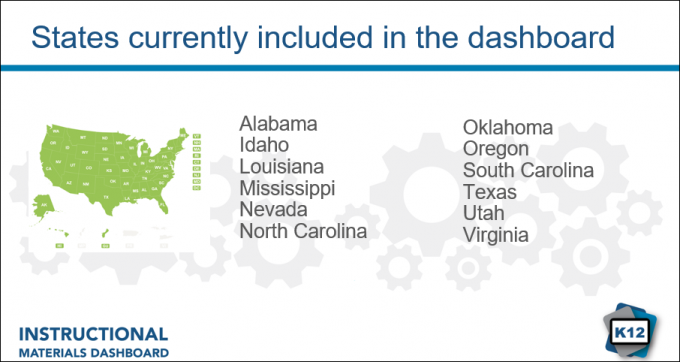A New Tool for Searching Out ‘High Quality’ Curricula
District and state educational leaders can now use a new dashboard to get a “one-stop” look at the core instructional materials that a dozen states have reviewed and approved as meeting their standards.
In its first phase, the K12 Instructional Materials Dashboard developed by the State Educational Technology Directors Association, or SETDA, focuses on a searchable database of learning resources for math and English/language arts curricula at the secondary level. The database contains 450 print and digital licensed products and open education resources.
The dashboard, which aggregates publicly available information from 12 different state websites, was launched recently via a webinar that about 700 educators signed up to attend.
It’s an “important responsibility for all educators to ensure that the resources you’re using are high quality, aligned to standards, specifically address educational goals, and of course, are accessible to all students,” said Christine Fox, deputy executive director of SETDA.
Texas is the largest state represented among the 12 that contributed their recommendations to the database. “California doesn’t review secondary materials,” said Fox in an interview. “They only do K-8. We are in conversations with them” about sharing their findings for the SETDA project, she said. [See the slide below for a list of other states participating.]

Not all states have review processes for K-12 instructional materials, and just because a state evaluates materials does not always mean districts in that state must buy from the “approved” list.
Tennessee is restructuring its review process, Fox said. Florida is undergoing a rapid-cycle review for a new list to match their standards. And West Virginia passed a law starting July 1 that it will no longer publish a list. Instead, educational leaders in that state will coach districts on a review process, Fox said.
The idea for the database came from state leaders and educators, said Fox. “Over the past four to five years, SETDA has been supporting the shift to digital instructional materials,” she said, and a central source of information about educational options was one request from state officials. The State Instructional Materials Review Association, which counts 20 states and Guam among members that evaluate instructional materials, partnered with SETDA on the dashboard project.
How to Use the Dashboard
Resources on the dashboard can be sorted by state, content area, subject area, grade level, format, publisher and copyright date. All entries in the database are full-course instructional materials, and there’s a link to the review processes used by the states In the first update, SETDA plans to add a tab to highlight each state’s relevant standards.
Beyond its potential use in states that review curricular materials, the dashboard could have broader appeal, according to Fox. For one, it can help educators and administrators narrow a search for materials. “If you’re from, for example, New Jersey—which does not have a state-level review process—but your district plans to adopt new math or English/language arts curriculum for secondary level students, you can see what states have vetted and reviewed, and maybe start with that shorter list rather than starting with everything that is available,” Fox said.
Utah is one of the states whose reviewed products are posted in the database. Asked whether EdReports.org, a nonprofit that provides reviews of K-12 instructional materials, is part of his state’s review process, Alan Griffin, the curriculum content specialist for the Utah State Board of Education responded: “We will often reference them in our own reviews. We do like the local perspective our own reviewers give, however, to Utah educators and the public.”
SETDA’s plan is to expand beyond the secondary grade levels with the dashboard, and ideally into new subject areas as well, said Fox. Science might be the next area of interest, as states and districts are looking for guidance on what products align with Next Generation Science Standards, she said.
The work to date has been funded by the Bill and Melinda Gates Foundation. Additional grants would be needed to expand the database, Fox said.
Follow EdWeek Market Brief on Twitter @EdMarketBrief or connect with us on LinkedIn.
See also:

This looks pretty cool. Thanks for sharing such stuff.